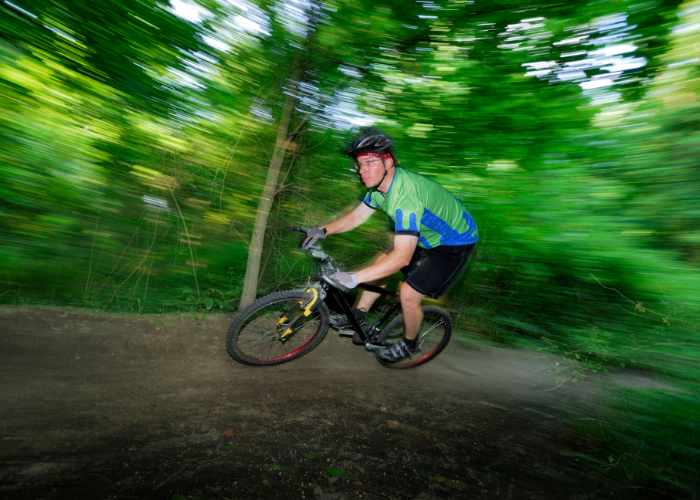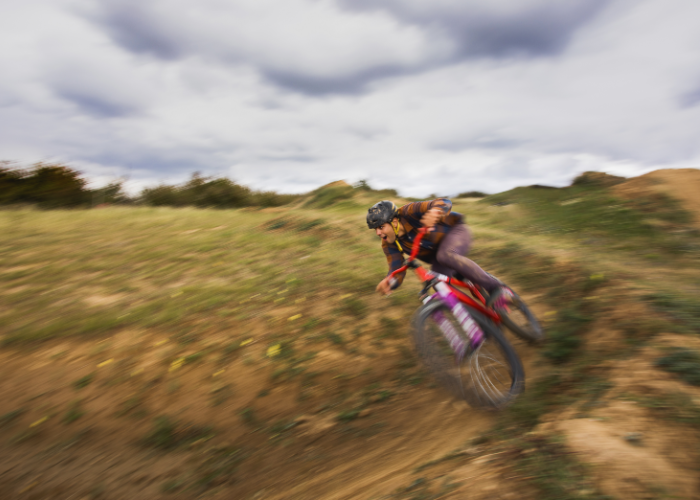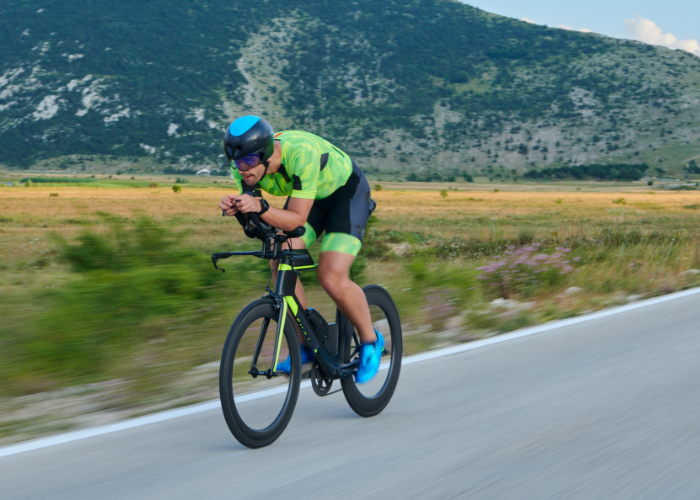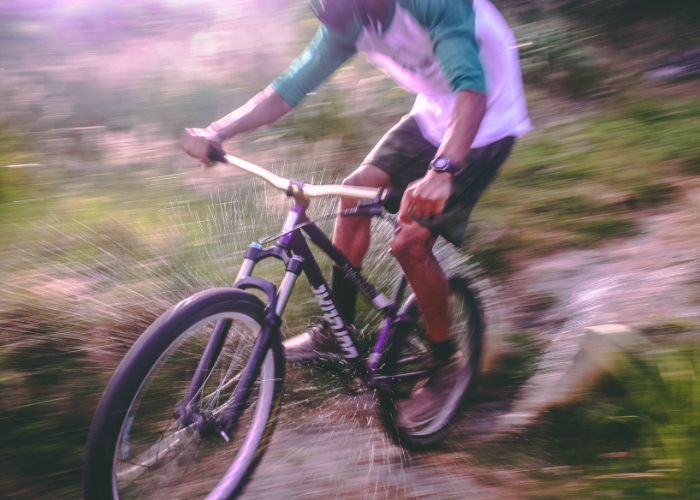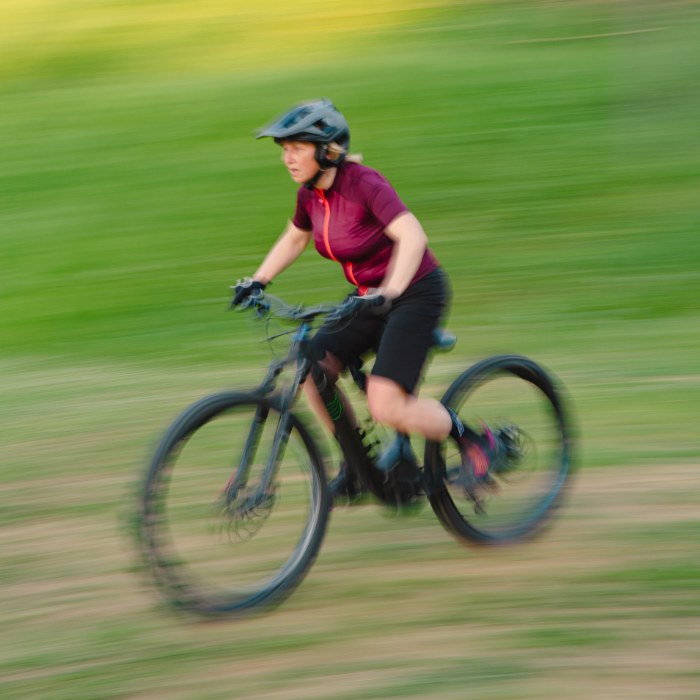Ever wondered, “How fast can a mountain bike go?”
In this blog post, we’ll explore the factors that affect mountain bike speeds and reveal how to optimize your ride for maximum performance. Buckle up and get ready to discover your bike’s true potential!
Factors Affecting Mountain Bike Speed
Mountain bike speed, or a bike’s speed in general, is influenced by numerous factors, including:
- Rider weight
- Riding position
- Terrain
- Gear ratio
- Tire size
While the average speed of a mountain biker ranges from 10-15 mph on trails, downhill mountain bike riding can reach speeds up to 30-40 mph.
To unlock your bike’s full speed potential, it’s essential to understand how these factors interact and impact your overall performance.
Rider Weight and Riding Position
The weight of the mountain biker plays a crucial role in determining speed, as heavier riders need more energy to maintain momentum. Moreover, adopting a more aerodynamic position reduces wind resistance and can significantly increase speed on a mountain bike. So, shedding extra pounds and refining your riding position can make a noticeable difference in your biking experience.
Terrain and Trail Conditions
Smooth trails with minimal rolling resistance are a mountain biker’s dream. But when faced with rough terrain, full of mud, rocks, and roots, you’ll need to slow down to maintain control and ensure safety.
As such, the type of terrain and trail conditions have a substantial impact on how fast you can ride your mountain bike.
Gear Ratio and Tire Size
A higher gear ratio and larger tires can help you achieve faster speeds on both mountain and road bikes. While a higher gear ratio requires more pedaling to rotate the rear wheel once, it enables the bike to reach its maximum speed at the same rate of pedaling.
Therefore, optimizing your gear ratio and tire size is a key factor in increasing your mountain bike speed.
Types of Mountain Bikes and Their Top Speeds
Cross-Country Mountain Bikes
Cross-country mountain bikes are designed for speed and efficiency on various terrains, from smooth trails to technical singletracks. These bikes are typically lightweight and have a more aggressive geometry, allowing riders to achieve top speeds around 30 mph.
To further enhance your cross-country mountain bike’s performance, consider optimizing tire selection, pressure, drivetrain maintenance, and body position and technique.
Downhill Mountain Bikes
Built for rapid descents, downhill mountain bikes feature long-travel suspension and a robust frame to handle steep, technical terrain. These bikes focus on speed and control during descents and can reach speeds of up to 40 mph.
However, they are not designed for uphill pedaling, so riders typically rely on chair lifts or shuttle vehicles to reach the top of the trail.
Mountain Bike vs Road Bike: Speed Differences
While road bikes are generally faster than mountain bikes on smooth surfaces due to design factors, mountain bikes can outperform road bikes on rough terrain. Road bikes tend to be lighter, have narrower tires, and more aerodynamic riding positions, making them faster on flat, paved roads.
However, mountain bikes can achieve faster speeds in off-road conditions thanks to their suspension systems and wider tires designed for better traction.
Design Factors
Road bikes are designed for speed and efficiency on smooth surfaces. Their lightweight frames, narrower tires, and aerodynamic riding positions contribute to their higher speeds compared to mountain bikes.
On the other hand, mountain bikes have front and rear suspension systems to absorb shocks and vibrations from rough terrain, enabling them to maintain speed and control in off-road conditions.
Performance on Different Terrains
Mountain bikes excel in rough terrain, where their suspension systems and wider tires provide better traction and control. In contrast, road bikes struggle on uneven terrain and are best suited for flat, paved surfaces. On average, a road bike tends to go 5 to 10 mph faster than a mountain bike on flat pavement.
However, when it comes to off-road adventures, mountain bikes can reach higher speeds and outperform their road counterparts.
Achieving Faster Speeds on a Mountain Bike
Optimizing your mountain bike for speed involves a combination of factors, including tire selection and pressure, drivetrain maintenance, and body position and technique. By focusing on these aspects, you can squeeze every last bit of speed out of your bike and enjoy the thrill of high-speed mountain biking.
Tire selection and pressure are key to optimizing your bike for speed. Choose tires that are durable.
Tire Selection and Pressure
Selecting the right tire for your mountain bike and optimizing tire pressure can significantly impact your speed and overall performance. Wider tires with more aggressive tread patterns are ideal for rough terrain, while narrower tires with less aggressive treads, such as road bike tires, are better suited for smooth trails and cross-country riding.
Additionally, running tubeless tires allows for lower pressures, resulting in better trail feel and reduced rolling resistance.
Drivetrain Maintenance
Maintaining your drivetrain is crucial for maximizing your mountain bike’s speed and performance. Here are some key steps to follow.
- Regularly clean and lubricate your chain.
- Check your chainrings and cassette for wear.
- Adjust your derailleur and chain tension. By following these steps, you can ensure smooth and efficient power transfer from your pedals to your wheels.
By taking the time to properly maintain your drivetrain, you can ensure that your bike is running smoothly.
Body Position and Technique
Improving your body position and riding technique can also help you achieve faster speeds and better control on your mountain bike. Focus on maintaining the right posture on the bike, engaging your core muscles for balance, and honing your cornering and handling skills.
These refinements will not only make you faster, but also provide a more enjoyable and safer biking experience.
Record-Breaking Mountain Bike Speeds
Fastest Downhill Mountain Bike Ride
The fastest recorded downhill mountain bike ride was achieved by Markus Stöckl, who reached a mind-blowing speed of 84.9 mph while riding down a 45-degree slope in the Chilean desert. This incredible feat demonstrates the extreme speeds possible in downhill mountain biking.
It also highlights the importance of proper protective gear and awareness for high-speed riding.
Top Cross-Country Race Speeds
Elite cross-country racers can achieve impressive average speeds during off-road races. Top cross-country race speeds have been recorded at 18.6 mph, showcasing the high level of skill and fitness required in this discipline.
These mountain bikers push the limits of their mountain bikes, demonstrating what’s possible with dedication, training, and the right equipment.
Safety Considerations for High-Speed Mountain Biking
As thrilling as high-speed mountain biking can be, it’s essential to prioritize safety to ensure an enjoyable and injury-free experience. This includes wearing appropriate protective gear such as a helmet, elbow and knee pads, and gloves. It is also important to practice good trail etiquette and awareness, such as being aware of the trail.
Protective Gear
Wearing proper protective gear, such as helmets, gloves, and pads, is crucial in reducing the risk of injury during high-speed mountain biking. Depending on the type of riding and the level of risk involved, additional protective gear like arm and leg armor may be necessary to ensure your safety on the trails.
It is important to make sure that all protective gear is properly fitted and in good condition.
Trail Etiquette and Awareness
Practicing good trail etiquette and being aware of other trail users is essential for a safe and enjoyable experience for everyone. This includes:
- Yielding to other trail users
- Staying on designated trails
- Avoiding blocking the trail
- Respecting the environment
By being mindful of your surroundings and following these guidelines, you can enjoy high-speed mountain biking while minimizing risks to yourself and others.
Summary
In conclusion, achieving high speeds on a mountain bike is an exhilarating experience that requires a combination of factors, including optimizing your bike’s setup, improving your riding technique, and adhering to safety precautions. By understanding the factors that affect mountain bike speed and applying the tips and strategies shared in this blog post, you can unlock your bike’s true potential, enhance your riding experience, and enjoy the thrill of high-speed mountain biking.
Frequently Asked Questions
Can a mountain bike be as fast as a road bike?
Overall, a road bike is significantly faster than a mountain bike; usually 10-30% faster on smooth roads with the same effort. Therefore, a mountain bike is not likely to be as fast as a road bike.
Is 30 mph on a mountain bike fast?
30 mph on a mountain bike is quite fast – downhill sections can reach peak speeds upwards of this, but usually average around 17 mph.
It is tougher to obtain on flat land compared to a road, with the max speed recorded at 25 mph.
How fast is a 21 speed mountain bike?
A 21-speed mountain bike can reach speeds of up to 44 mph, given a fit rider and good gear ranges.
What factors affect mountain bike speed?
Rider weight, riding position, terrain, gear ratio, and tire size all affect the speed of a mountain bike, so adjusting these factors can lead to an improved performance.
By changing the rider’s weight, riding position, terrain, gear ratio, and tire size, the speed of the mountain bike can be improved. This can be done by making small adjustments to each of these factors, or by making larger changes to one or more of these factors.

